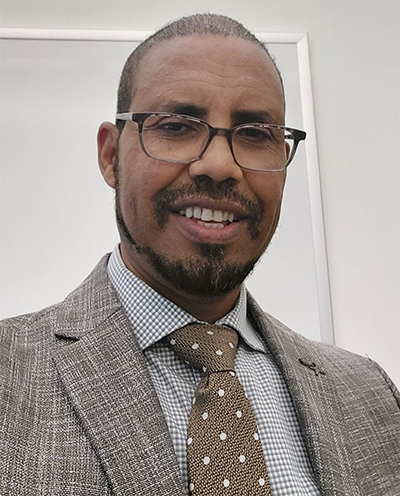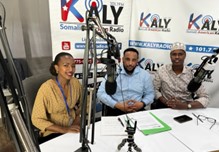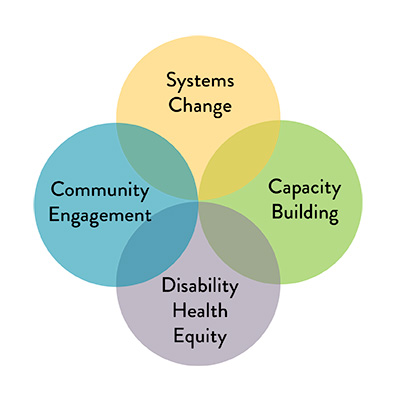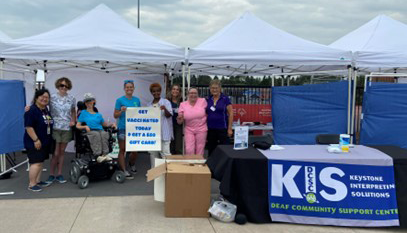Center for Health Equity Newsletter November 2023
In this newsletter:
Greetings from the Center for Health Equity
Message from the Director
CONNECT: CHE welcomes nearly 100 new grantees
STRENGTHEN: Sights set on transformation
AMPLIFY: Partnership in serving people with disabilities
Greetings from the Center for Health Equity
We are thrilled to be back with this November newsletter after a brief hiatus. We have a lot to share and a lot to be grateful for as the Center for Health Equity continues to grow and evolve. Pre-pandemic, the CHE team was a small but mighty group of about a dozen staff; today, we are more than 40 staff and counting. Learn more about our robust and growing team on our Contact Us page.
We continue to undergo changes as we incorporate programs and lessons learned from our pandemic work (with many of you, our community partners) into our long-term structures, as well as stand up new programs funded through recent State legislation. Some of these new initiatives will be housed within CHE, and others in the Minnesota Department of Health (MDH) Health Equity Bureau. They include:
- Advancing Equity Through Capacity Building and Resource Allocation: establishes a grant program to support metro and rural community and faith-based organizations serving populations of color, American Indian, LGBTQIA+, and those with disabilities in Minnesota who have been disproportionately impacted by health and other inequities to be better equipped and prepared for success in procuring grants and contracts at the department.
- Community Solutions: establishes an ongoing grant program to improve child development outcomes and the well-being of children of color and American Indian children from prenatal to grade 3 and their families.
- Health Equity Advisory and Leadership (HEAL) Council: establishes in statute the advisory council representing voices of communities most severely impacted by health inequities across the state to advise and hold MDH accountable for removing barriers to health equity.
- Office of African American Health: establishes an office dedicated to addressing the root causes of health inequities that disproportionately impact Minnesota’s African American communities as well as a statewide African American Health Advisory Council.
- Office of American Indian Health: establishes an office dedicated to addressing the root causes of health inequities that disproportionately impact Minnesota’s American Indian communities, focusing especially on addressing historical trauma and systems change in its early years.
- Office of Diversity, Equity, Inclusion and Belonging: provides ongoing funding for this office to advance policies and practices at MDH that promote a diverse, equitable, inclusive, and accessible workplace in which all employees feel that they belong and are valued.
We look forward to updating you on our progress in establishing and implementing these exciting new initiatives in future newsletters. In the meantime, read on for a message from Assistant Commissioner Dr. Halkeno Tura, an introduction to more than 100 new grantees at CHE, an overview of our systems transformation work, and more!
[Interested in being a guest writer for a future newsletter? Email your idea to health.equity@state.mn.us and we will be in touch!]
Message from the director

As some of you may know, I assumed the position of assistant commissioner of the Health Equity Bureau earlier this year. Since then, I have been wearing two hats. I expect this to be my final communication as the Center for Health Equity Director.
Despite changes in my role, my commitment to promoting equity remains steadfast. I believe health equity is achieved when systems support all people and communities to have the opportunity to be as healthy as possible no matter who they are or where they live. I envision a comprehensive transformation that includes structural, relational, and narrative (mental model) changes. My goal is to center equity in the state public health system sustainably through two main approaches: system transformation and fostering a sense of belonging.
The COVID-19 pandemic has brought to light long-standing disparities and highlighted the significance of health equity as a foundational capability needed for the success of state, national, and global public health. The COVID-19 pandemic has also highlighted the importance of equity, not only in terms of outcomes but also in terms of the diverse workforces that serve communities.
In this issue of the newsletter, I would like to share one reflection that keeps me up at night – the critical role of a sense of belonging in advancing racial and health equity.
For the last few years, I have been focused on the importance of fostering a sense of belonging in all of our shared spaces. As I talk about the liberating power of belonging, I often get a question like this: “If we are already focusing on diversity and inclusion, why do we really need to focus on belonging? Isn’t belonging the same thing as diversity and inclusion?” I also hear and read some people saying or writing that belonging is just another buzzword, because people are tired of talking about diversity and inclusion.
Let’s unpack this a little, shall we?
The feeling you never forget. We all have and remember the moment or moments when we felt we didn’t belong. It’s not a feeling we forget. Even as a child, you develop Spidey-senses for it. The feeling of not fitting in because of something you can’t control or because of who you are can teleport you right back into that sad, pit-in-your-stomach feeling. Growing up, I had first-hand experience with this type of feeling. The need to belong is an emotional need to be accepted for who you are. According to Maslow, the need to belong is so basic to our humanity that we must satisfy that need before we can fully develop our self-esteem and confidence.
Have you ever thought or wondered if one of your team members feels they have to filter major parts of their identity or true self out of their professional persona? If they check a part of who they are at the door each day? Think of that sad, pit-in-your-stomach, soul-destroying feeling of not belonging. Now, imagine how painful it must be to bear that sense of exclusion every day at work to make a living. And think how that impedes the efforts to advance racial and health equity.
Diversity and inclusion efforts are worthwhile and necessary, but we often fail to recognize that just because someone is included in our agency doesn’t necessarily mean they feel they belong. The benefits of inclusion are real and tangible, but they do not get us to the finish line. Creating a diverse workforce through several mechanisms is an essential first step. However, it is not sufficient to sustain our public health progress. In a culture where people are devalued, shamed, and/or discredited because of who they are, how they look, where they are from, disabilities they live with, or gender identity and sexual orientation they identify with, hiring diverse people alone is not much more than a number. When being human is not enough to be accepted, valued, and respected, some have to work twice as hard to prove their significance in their settings, which creates a psychological trauma that impacts how they navigate and exist in that setting. In such environments, people try to conform to the dominant culture in order to be seen and included or reject their whole selves to be accepted and make others comfortable.
Diversity and inclusion alone are insufficient in a workplace where some members of a “diverse” workforce feel like they must codeswitch or downplay aspects of their identity. Diversity is the measure (the statistics or number), and inclusion is the method, but neither of them is an outcome. Diversity and inclusion do not always create a sense of belonging. An inclusive work culture that values people for their differences and empowers them to participate and contribute freely does. Thus, we need to do more than just hire diverse people by instituting policies and practices that promote a culture of belonging.
Belongingness involves structural, relational, and other transformational changes needed for all of us to share power and co-create an equitable and healthy society together. Creating a workplace that fosters a sense of belonging is about the actions and behaviors we demonstrate to enhance a culture in which employees feel valued, trusted, and authentic. In such a workplace, everyone is encouraged and supported to contribute fully and thrive. A workplace culture where everyone feels they belong helps build trust with each other and better understand the complex structural biases that perpetuate stereotypes and inequities.
While I recognize that creating an environment that nurtures a sense of belonging isn’t easy, especially after going through one of the most traumatic pandemics in human history, which resulted in a heightened period of othering, having a strategy that sets the tone and direction for inclusive workplace culture can be instrumental to get us there. Such strategy includes clear roles and accountabilities along with specific goals and initiatives that are customized to our needs and challenges. In summary, diversity, inclusion, and belonging must go hand in hand.
Belonging is the feeling of being accepted for your authentic self. Directors, managers and supervisors are often accountable for building a sense of belonging, but keep in mind these leaders are employees, too. While employee sense of belonging is a leader-driven activity, leaders’ own sense of belonging needs to be considered as well. This means that each of us, irrespective of our position, title, or responsibilities, has a critical role to play in creating a workplace that not only prioritizes the key values of diversity and inclusion, but that also makes sure that every employee carries with them a true sense of belonging in their work.
Thank you, galatoma, obrigado, gracias, amesegnalehu!
Dr. Robsan (Halkeno) Tura MA, MPH, CHES, PhD; assistant commissioner, Health Equity Bureau
CONNECT

[We are a network hub – leading, connecting and strengthening networks of health equity leaders and partners across MDH and Minnesota communities.]
CHE welcomes nearly 100 new grantees
The Center for Health Equity is dedicated to promoting health equity by supporting communities to drive their own solutions to persistent health challenges. One of the ways we do this is through grants, which fund locally driven, culturally rooted programs. Our newest grant initiative is the COVID-19 Community Engagement and Diverse Media (CE/DM) program, which welcomed 63 new grantees in May and June of this year. Meanwhile, our oldest grant program, the Eliminating Health Disparities Initiative (EHDI), welcomed another 31 in July and August.
Launched during the hectic early days of the pandemic, the CE/DM program recognizes the critical role of effective and trusted communication in combating inequities in COVID-19. Our staff work with diverse grantees across the state to disseminate critical, timely information in languages, formats, and through messengers that are trusted. To learn more, visit the CE/DM website. A full list of grantees can be found on the grantee page [EXPIRED LINK]. Examples of content developed from partners early on in the pandemic can be found on the COVID-19 Examples of Contractor Materials and Messages page.
The CE/DM program partners with a diverse group of grantees deeply embedded within their respective communities. These grantees serve as trusted messengers, working closely with community and religious leaders to ensure that COVID-19 information is culturally tailored and language-appropriate. This culturally relevant approach has effectively dispelled fears and countered misinformation, which initially hindered vaccination efforts.
Approximately $7.5 million in funding was made available for multiple grant awards in this most recent cohort (2023-24), ranging from $24,000 to $175,000. This financial support allows grantees to adapt or develop media messaging and engage with communities effectively. The CE/DM program has significantly bridged trust gaps and empowered communities with accurate information, making residents better informed and receptive to culturally nuanced messages.
Meanwhile, CHE continues to support the long-running Eliminating Health Disparities Initiative (EHDI) grant program. Established in 2001 by the Minnesota State Legislature, EHDI is designed to address health inequities for populations of color and American Indians. It focuses on investing in community-based organizations and tribes, ensuring that health improvement strategies are rooted in cultural knowledge and community strengths.
EHDI allocates approximately $5 million annually to community initiatives targeting populations of color and American Indians across eight priority health areas. Over the years, the program has supported organizations and projects run by and for these communities, developing tailored strategies for effective outreach. The current grant cycle, initiated on July 1, 2023, supports 31 organizations until 2027. This sustained investment empowers organizations and projects to develop effective strategies for reaching and engaging those experiencing health inequities, ultimately reducing health disparities.
Both the CE/DM and EHDI programs align with MDH's broader mission of ensuring that all residents, regardless of their cultural or linguistic backgrounds, have access to vital health information and resources. By supporting these initiatives, Minnesota takes significant strides towards achieving health equity in Minnesota.
Okash Haybe, a CE/DM grant manager, underscored MDH's goal of reaching communities in culturally responsive ways, emphasizing the importance of these grants in achieving this mission. "In response to the COVID-19 pandemic, the department has collaborated and partnered with community-based organizations and various trusted media vendors to create and disseminate culturally relevant, linguistically appropriate, accurate, and timely messages related to COVID-19 and vaccines to communities,” Haybe said. “The role of community engagement and diverse media grantees has been crucial in reaching the communities in culturally responsive ways and has helped enhance the public understanding of COVID-19, the importance of vaccination, and other key public health measures."
Already this year, CE/DM grantees have reached nearly 2 million people with messages related to COVID-19. The most engaging strategies reaching the most people so far have included digital ads, social media posts, and radio ads. These grants are slated to end in June 2024.
STRENGTHEN
[We provide leadership in advancing health equity and cultivate health equity leaders within MDH and across Minnesota communities.]
Sights set on transformation

Since its inception in 2013, the Center for Health Equity (CHE) has had a diverse and evolving array of programs and initiatives aimed at advancing health equity within the department and across Minnesota. Across it all, two central pillars underpin that work: authentically engaging our community partners, and working to change policies, practices, and systems to eliminate structural racism and inequities.
Since the fall of 2022, a core group of CHE staff have been working toward these aims. The group’s primary areas of work include increasing the capacity of staff at MDH to engage with and work in collaboration with all communities in Minnesota; amplifying community presence in decision-making spaces and connecting community partners to MDH resources; and eliminating systemic barriers to belonging, power-sharing, and community engagement.
In line with the goal of integrated, systemic advancement of health equity, the work of this group straddles internal and external spaces. Within MDH, these staff provide technical assistance and health equity coaching; facilitate structural, equity-oriented revision of MDH policies, practices, and procedures; and advance more equitable data standards around race, ethnicity, language, sexual orientation and gender identity (SOGI), and disability status. In the community, CHE staff co-lead outreach and engagement activities to connect with community leaders and community-based organizations statewide. This includes deepening existing relationships and creating opportunities for community partners to leverage their power and expertise to influence MDH priorities.
CHE staff tasked with this important work include both new colleagues and veteran MDH employees previously deployed to the COVID-19 response, all of whom bring a passion for creating equitable systems and a wealth of professional and lived experience working with communities of focus. They include:
- Marisol Chiclana-Ayala
- Amy Lopez
- Nancy Lee
- Jeanett Garcia
- Sandy Johnson*
- Kody Olson
- Mattie Laidlaw*
- Pam Willow*
- Ibrahim Dirie
- Hannah Summers
- Krista Hoch*
The work of health equity belongs in all parts of MDH and all levels of the public health system. These CHE staff aim to expand and integrate their work through partnerships and collaboration throughout MDH and across the enterprise. Initial engagement activities have included co-leading the Cultural, Faith, and Disability Communities Collaborative, the Community Engagement Practitioners Group, and the Interdepartmental Disability Health Equity Collaborative. Additionally, these staff at CHE have established a new cohort of equity trainers and coaches who are available to support internal and external partners, and they have built a framework for tracking and addressing systemic equity concerns that arise within our organization.
CHE is eager to include as many voices as possible in this exciting, transformative, necessary work; please reach out to Marisol Chiclana-Ayala with any questions or opportunities for partnership. She can be reached at marisol.chiclana-ayala@state.mn.us.
*As of fall 2023, Mattie Laidlaw, Pam Willow, Sandy Johnson, and Krista Hoch have begun new positions. Mattie and Pam are serving on a new team of Health Equity Strategists in CHE, Sandy has been reassigned to the Office of African American Health, and Krista has taken a role in the Infectious Disease Epidemiology, Prevention, and Control Division at MDH.
AMPLIFY
[We amplify the work of communities most impacted by health inequities and support them to drive their own solutions.]
This article is part of a series of stories about community outreach and partnership in response to the COVID-19 pandemic. Learn more and find more stories on the COVID-19 Stories of Community Outreach and Partnership page.
Partnership in Serving People with Disabilities
The beginning of the COVID-19 pandemic highlighted and exacerbated existing gaps in equitable situations for people with disabilities. The community experienced disparities in accessing health care services, critical public health information materials, and effective communication services. People who are deaf and people with vision and hearing loss experienced unique challenges in navigating testing, vaccination, and health information resources.
Recognizing the need to address these health inequities, the Minnesota Department of Health (MDH) partnered with Keystone Interpreting Services (KIS) to reduce barriers in accessing COVID-19 information, testing, and vaccination resources.
The work of KIS
Keystone Interpreting Services Minnesota (KIS) is a partnership organization of two nationally known deaf and hearing interpreters (Jimmy Beldon and Patty McCutcheon) with over 30 years of community-based interpreting and translation experience. They provide services to people who are deaf, blind, and hard of hearing.
Thanks to an MDH grant contract, KIS established the Deaf Community Support Center (DCSC) to provide vaccination, testing and health recovery programming to Minnesota’s disability communities. KIS uses its team of certified American Sign Language (ASL) interpreters and technical expertise as the backbone for the DCSC’s work. Their ASL interpreters have extensive training for situations that call for more advanced cultural and linguistic communication.

Establishing DCSC
The establishment of DCSC was driven by emerging community needs. Facing numerous accessibility barriers to COVID-19 testing and vaccination resources, communities reached out to Beldon to help them address these barriers. This led to the formation of an organization deeply embedded in the community to advance Beldon’s vision.
At the start of the pandemic, KIS worked with MDH to address some of these accessibility challenges. For example, there was unclear public health messaging and lack of accessible messaging targeting those living with disabilities.
To address this information gap, "DCSC offered both in-person and virtual trainings to community partners in basic sign languages. Trainings were tailored to meet the language and organizational needs of the people served," said Jasmine Rademacher, former DCSC community specialist. Their work also revolved around holding workshops on COVID-19 prevention information and raising awareness on the importance of masking, testing, and vaccinations.
Additionally, DCSC supports community partners with tips in website development and improvement to improve accessibility for people who have low vision or are blind and people who are hard of hearing. They also increase community awareness of available resources that provide accommodations.
Reaching out to communities
Through MDH, DCSC connected with the Deaf Hard of Hearing Services Division (DHHSD) at the Department of Human Services to provide interpreting services to its network of partners to make testing and vaccination services for COVID-19 and flu accessible to people who are deaf, deafblind, and hard of hearing.
In 2022, DCSC hosted its first vaccination event for the deaf community at DeafNation Expo, a national gathering that took place in Minnesota. Incentives were provided to those who received their COVID-19 vaccination. MDH supported the event by providing a licensed medical team, supplies, and logistics.
"We exceeded our target, as many people from Ramsey and Washington County turned up for the event," said Amanda Smith, DCSC community specialist. The community gave positive feedback expressing their appreciation for the resources and support for people with hearing and vision disabilities during the event.
Much of DCSC's work is driven from experience working with deaf schools and communities. "Jasmine and I grew up in the deaf community and identify with the needs of our members. We are here to bridge the gap between MDH and the deaf community to make services more accessible," said Smith.
DCSC also collaborated with Homeland Health, Odam Medical Group, and Minnesota Health Fairview to help host vaccine events providing ASL interpreters and language translators.
Partnering with other community partners
DCSC held workshops in schools and communities to explain COVID-19 information and provide details on where to access different resources. They partnered with Special Olympics Minnesota, Minnesota State Academy for the Deaf (MSAD), Metro Deaf School in Saint Paul, and other partners to distribute 2,000 testing kits. DCSC also supported the community by providing knowledge and skills training to better serve people with disabilities.
DCSC has successfully reached out to 170 networks in Minnesota – including rural regions where there is limited access for the deaf, deafblind, and hard of hearing community. DCSC plans to make their services more visible and known even outside the Minnesota Twin Cities metro area. Its services are funded by state grants and are free for other community partners to access. Rademacher shared DCSCs vision for expanding their networks with public schools to provide mental health workshops for students recuperating from the impact of the COVID-19 pandemic. These workshops engage them in virtual yoga sessions and various hands-on game activities to help them gain confidence in their social comfort zone.
Future work
MDH continues to respond to the needs of the deaf, deafblind, and hard of hearing communities in its post-pandemic recovery period. Through several cross-agency workgroups, including the Disability Health Equity Collaborative and the Disability Data Affinity Group, the agency is devoted to strengthening its platforms for community engagement to elevate the needs and concerns of people with disabilities.